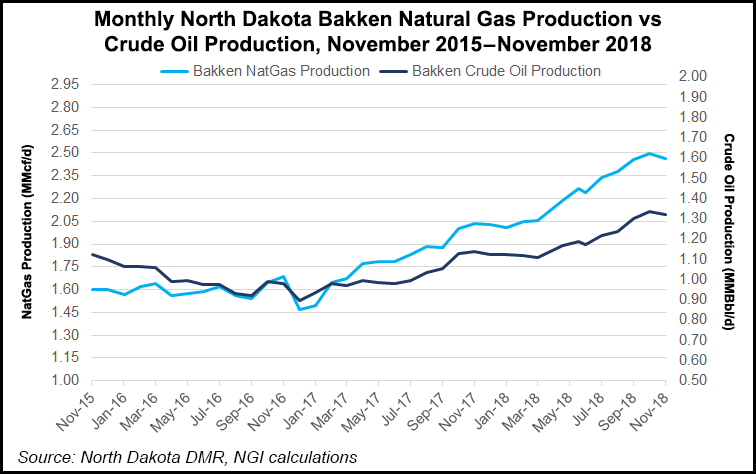Bakken Shale | E&P | NGI All News Access | NGI The Weekly Gas Market Report
Bakken Operators Using Drones to Improve Oversight
North Dakota oil and natural gas operators throughout the Bakken Shale have continued to polish their image for innovation and technology on the ground at well sites, and now they’re looking skyward by deploying drones to further that reputation.

As in most basins onshore and in the Gulf of Mexico (GOM), Bakken operators are using unmanned aerial systems (UAS) that collect data, monitor infrastructure and provide real-time operating solutions for various industries.
“I absolutely continue to be amazed at the advances in technology,” said President Ron Ness of the North Dakota Petroleum Council. “This includes the ability to monitor remote operations, and we’re seeing worldwide attention for the Bakken as a result.”
It’s part of the high-tech oilfield, with UAS employed in remediation and reclamation practices, automated wellsites.
Ness said North Dakota is one of the big areas for UAS monitoring today. “Drone activity here is very high — monitoring pipelines, monitoring facilities, and reviewing reclamation sites, or looking at easements.”
Bakken operators are far from the first to deploy drone technology. Five years ago, four companies initially were cleared by the Federal Aviation Administration to conduct flyovers of oil and gas installations in the GOM. Utilities also for several years have been using the technology to monitor operations.
Fargo, ND-based OmniByte Technology CEO Ray Berry said his company has “a forward vision and commitment” to use the technology to improve field services.
“Drones are already being used for inspections of vast areas, buildings, critical infrastructure (bridges, pipelines and the electric grid) and more where human safety, logistical and resource challenges are present,” said Berry. “What we know is there will be a tremendous amount of data collected, and it will need to find a way to be stored, used and integrated into business solutions.”
Growth areas for drones are infrastructure inspections and safety/security monitoring, according to Berry. “The ability for this sort of visual aid to identify defects or wear on oil and gas pipelines allows organizations to maintain these critical systems that are vital to U.S. energy independence and energy companies managing their costs to remain profitable during low-price periods.”
UAS is regulated, and there also is state support, he said. “We also have a great landscape for testing and proof-of-concepts for UAS use, and the University of North Dakota in Grand Forks plays a key role.”
© 2024 Natural Gas Intelligence. All rights reserved.
ISSN © 2577-9877 | ISSN © 1532-1266 | ISSN © 2158-8023 |
